Have you ever stumbled upon a product description that was so dull and lacking in detail that you had no idea what you were actually buying?
It can be frustrating, especially when you’re searching for those specific details that make a product stand out from the rest.
The truth is, in today’s competitive ecommerce landscape, you need to have a compelling product description that stands out and convinces potential customers that your product is the one they need.
On the other hand, I’ve personally been swayed to purchase products solely based on a compelling product description. It’s amazing how much of an impact well-written copy can have on our purchasing decisions. A great product description not only informs customers about the features and benefits of a product but also helps to build an emotional connection with them, making them more likely to make a purchase.
As an ecommerce store owner, having poor product descriptions can significantly harm your ability to drive sales. It’s crucial to put in the time, thought, and consideration into creating copy that truly resonates with your target audience. B
y taking the time to craft engaging product descriptions, you’ll not only drive more sales, but you’ll also increase your customer retention rate and improve your overall brand reputation.
But how do you write a great product description?
It all starts with understanding your target audience and their pain points. What problem does your product solve, and how can you convey that in a way that resonates with your customers?
Next, focus on the benefits of your product, not just the features. Benefits explain how your product will improve the customer’s life, whereas features are simply the technical details.
In this post, I’ll be sharing my own personal process for crafting product descriptions that not only grab attention but more importantly – drive sales!
From identifying your target audience to crafting a compelling headline and incorporating social proof, I’ll cover everything you need to know to write product descriptions that convert.
Write copy for your buyer personas
Most product descriptions out there look like they’ve been written just to put some text on the website or because someone forced the owner to do it against his will.
Another major mistake is to try to write copy for anybody who might visit the page in order to convert him into a customer.
Realize this: Different people have different reasons for buying a product, so you can’t target them all, in the same way. If you want to improve your conversions and maximize your sales, you need to write specific copy that appeals to them.
Here’s how to do that:
Understand your target customer – The best copywriters in the world are able to write product copy that converts because they understand their target audience. By doing so, their copy is able to empathize with the target prospects and addresses all the purchase objections.
That’s why it’s smart to do your research right in the first place and ask yourself:
- Who are my customers? What’s their situation?
- Why why do they want to buy my product? What needs do product solve? What kind of desire do my product fulfill?
- Why would they prefer your product instead of your competitor’s product?
- What kind of words or phrases do they use to describe your product?
- What objection would prevent them from buying your product?
Develop buyer personas – You’ll then use the information you’ve collected in your research to create buyer personas (a summarized version of your ideal customers). This allows you to have a global vision for your audience when it comes to your copy.
Remember to target only 1 buyer persona with each product description or you might fail to achieve some meaningful results.
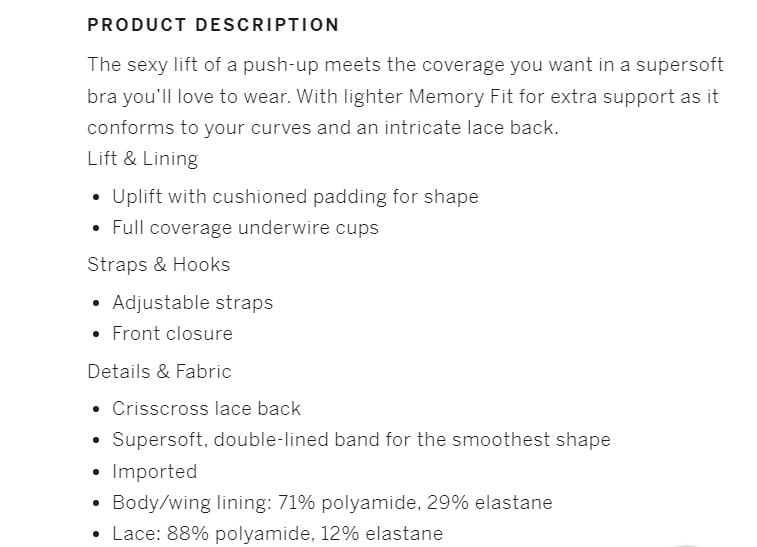


When you read the product descriptions of Victoria’s Secret, it’s evident they’ve put in the time to understand what their audience wants.
Their target audience is women who want to feel sexy, classy, and comfortable at the same time. So that’s why you will see words like “supersoft,” “sexy lift,” “the coverage you want,” “memory fit” and “extra support.”
Food for thought, how do you know if the bra provides “the coverage you want” until you try it on?
Focus on the solution, not the product


There’s an old adage among direct marketing copywriters that if you have a hardware store and you’re selling drills, you’re not really selling drills— you’re selling “holes in wood.”
The same is true for ecommerce. People aren’t so interested in the products themselves but what they can achieve or get with them.
So does your product:
- Solve any current need that your target customers might have?
- Help them achieve a dream or big goal?
- Give them pleasure and good emotions?
- Help them avoid pain and discomfort?
- Provide them with social status and increase their chances with the opposite sex?
If it does, this should be the focus on your copy since this is what will grab the attention of your target customer. This is why he wants to buy the product, and this is why he will.
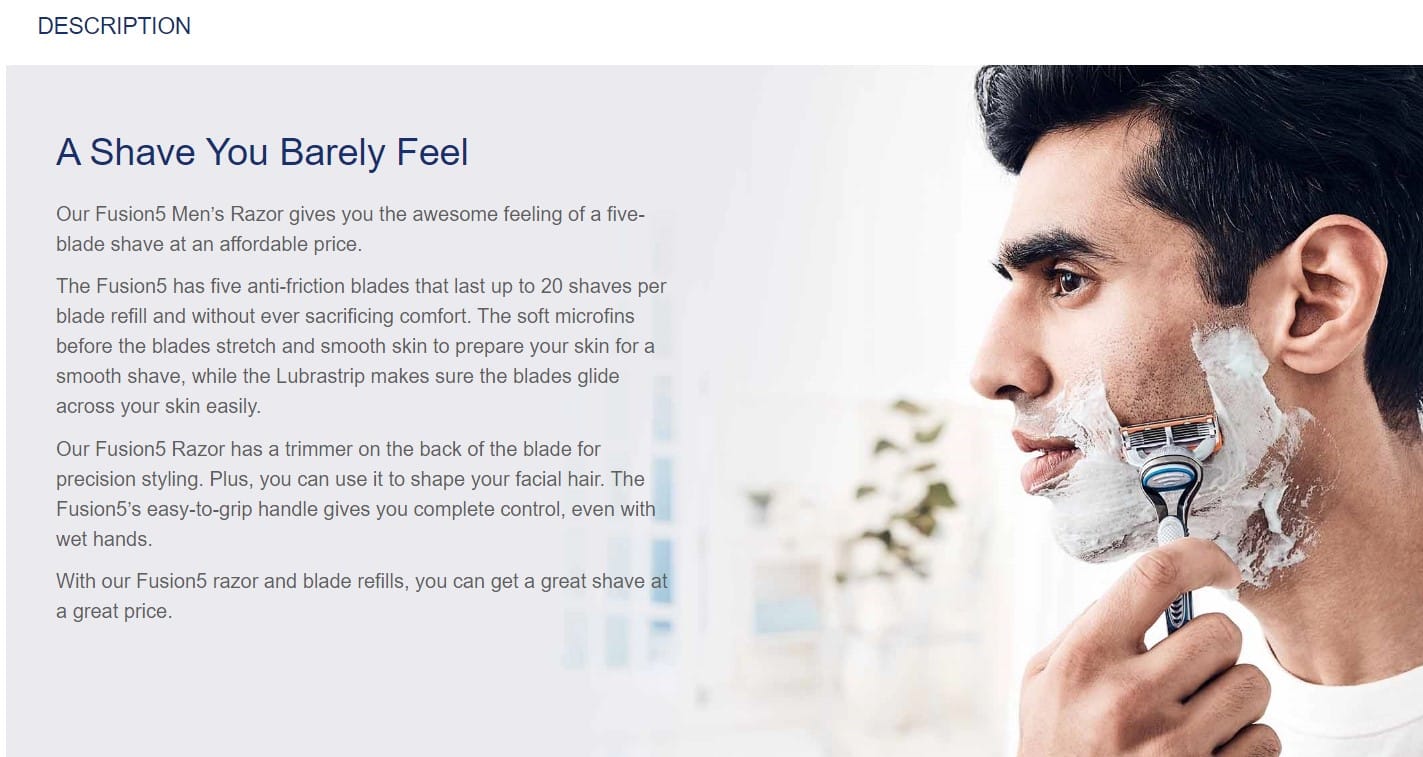


When you read the product description of Gillette Fusion, you immediately understand what you’re going to get – a high-class razor that will get virtually every hair. That’s what people who shave actually want.
Highlight the experience of using the product


The best way to sell any product to your target customers is to make them imagine they’re already using it. This makes them feel like they have already bought the product and more attached to it.
A recent study proves that ownership imagery can be used to increase the desire to purchase a product by having the buyers imagine that the object is already theirs. Good copywriters know how to write product descriptions that let the audience picture themselves already having and using your product.
To successfully do this you need to:
- Use words like “imagine,” “picture yourself,” etc.
- Explain how the customer will feel when she uses the product
- Let him imagine his current needs being met by using your product
- Use future and present tenses to let your customer feel like she bought your product already
- Use sensory language and words to integrate the five senses into the writing (sight, sound, taste, touch, and smell)


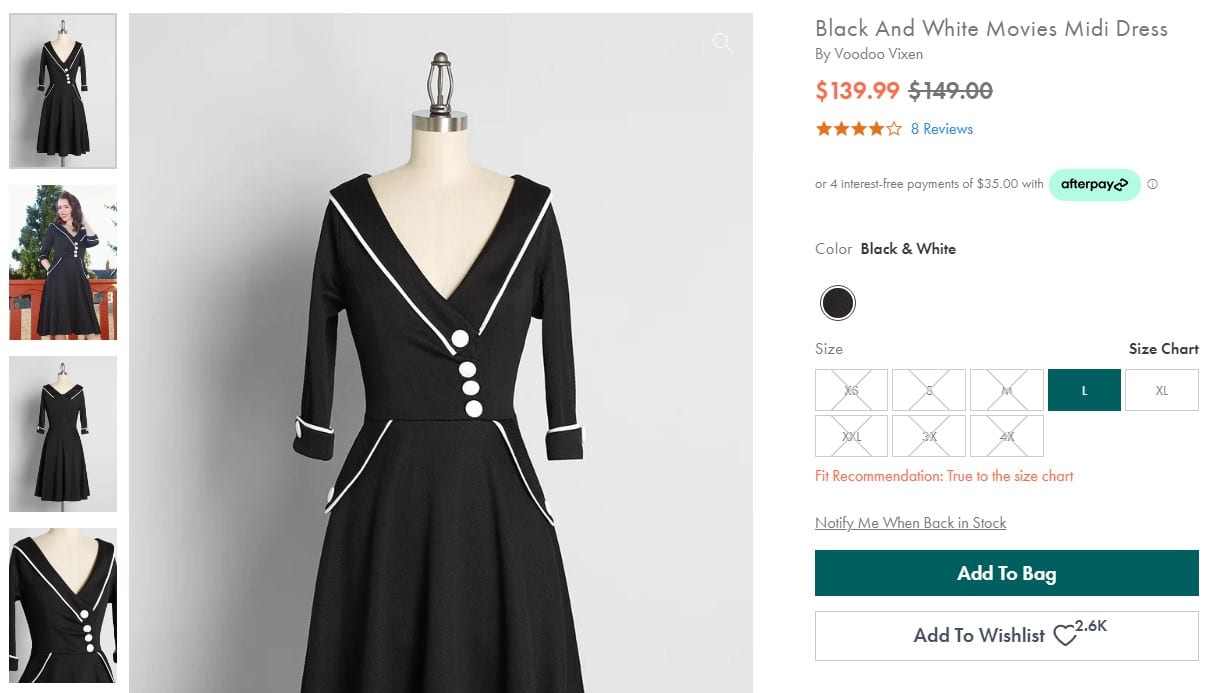
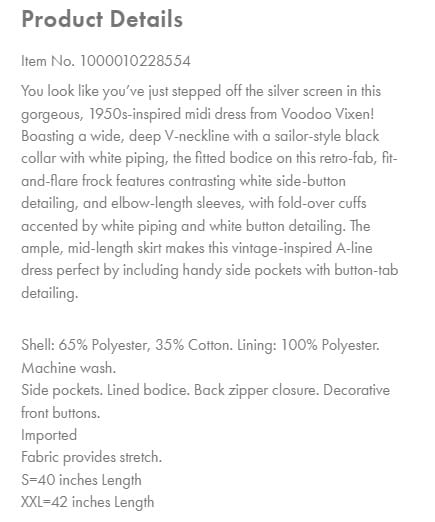
A great example of a product description that uses this is “Black And White Movies Midi Dress” in the ModCloth store.
The copy leads the reader to imagine already having the dress in her closet and how it looks on her in the mirror.
Understand the difference between features, advantages, and benefits


Ineffective copywriters don’t understand the difference between features, advantages, and benefits, or how to use them efficiently to sell more products. When used the right way, they can help you increase sales. At the same time, if used the wrong way they can make the customer less likely to buy.
So let’s try to distinguish them and see when to use each in your product description:
Features – This includes all the facts, data and characteristics about your products. Things like size, weight, color, functions, etc.
By nature, features are unpersuasive and doesn’t help you much with selling your product. In fact, listing lots of features increases the customer’s sensitivity to price since it makes them wonder if the expensive product is really worth it.
Features, however, can help you with selling low-cost products. That makes the customer feel extra positive about the lower price tag since he expected to pay more for the item.
Typical features of Samsung 40’’ TV look like this:
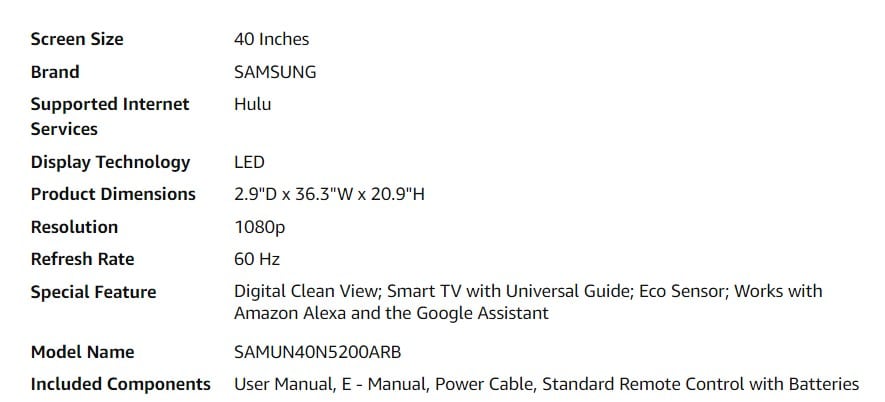


Advantages – They show how the product or its features can help the customer. For instance, a lighter laptop is easier to carry around.
The problem with advantages is that they raise concerns and objections by your customers. If you overuse them, they will start wondering if your laptop is really as fast as you say and if they really need it at the moment.
When you use too many advantages, people go into defense mode and they try to come up with all the reasons why they shouldn’t buy your product right now. That’s why you should use advantages carefully and switch to benefits instead.
The other thing is that people might not need or care about these advantages at all. You don’t need a lighter laptop if you’re in the office all the time and you occasionally move it from space to space.
The advantages of Samsung 40’’ TV look like this:
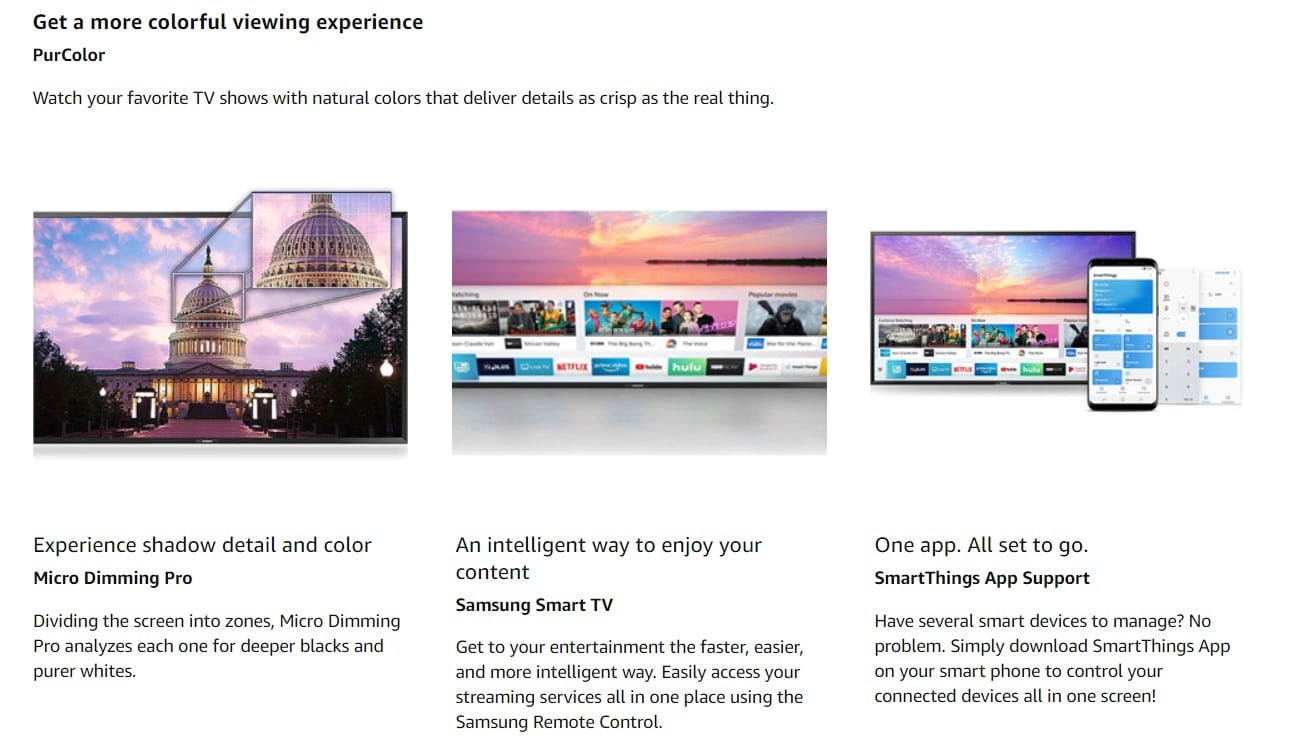


Benefits – They show how the product or its features meet an explicit need that your customer has at the moment. It differs from advantages in that benefits focuses on the solution your target audience wants at that exact moment.
In this case, a business person who is travelling around the world for six months out of the year will really find the benefits in a lighter and easy to carry laptop. On the other hand, this won’t be of much value for someone who just stays in the office. It all depends on your buyer persona.
In order to create benefits for your products, you must take the time to understand your customers and determine how to meet their needs with what you’re offering. Once you know that, writing an effective product description will be much easier for you.
This is a great example of a benefit-driven product description by Mothercare.com:
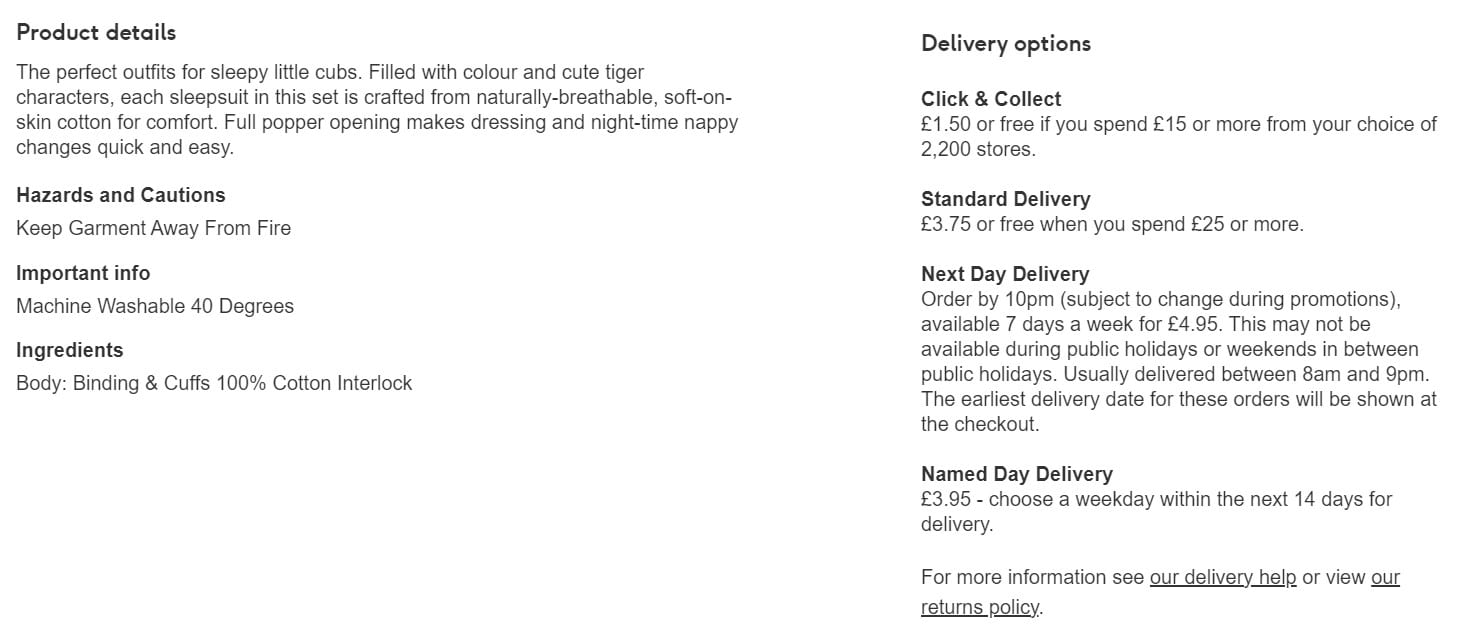


Avoid clichés and jargon


Using clichés and jargon in your product descriptions can diminish how you look in the eyes of your customer. You could lose overall credibility and affect your customers’ trust in your brand, so be careful.
Here’s what you need to know to protect yourself:
Jargon – Each time you use a word that your target audience doesn’t completely understand, you create friction that only helps break the sale. You might think that using jargon and technical terms makes you seem smart, but it will only confuse the customer.
Some great examples of jargon are words like bandwidth (the difference between two frequencies), dead-tree version (a printed document or publication), legacy media (radio, television, newspapers), etc.
When the customer doesn’t understand a term, he won’t put effort into searching for the meaning. Instead, he will most likely blame you for writing bad copy and not using words that he is able to understand.
Keep in mind that jargon might have a positive impact on sales if you’re talking to sophisticated buyers. It adds to your credibility and helps you build trust. In all cases though, it’s best if you don’t overuse them in your description.
In this case, you might use words like “plug-and-play,” “3D interface,” etc. to better describe your product.
In case you still need to include them, do so in the “know more” or “technical specifications” section and keep your product description simple.
Clichés & common buzzwords – These are overused words and phrases that no longer have positive impact. They make your customers roll their eyes and say to themselves “Oh, not again.”
But why is that?
When researching the topic of storytelling, scientists found that there are some words that are so overused that they have lost all of their power.
It was discovered that clichés and common buzzwords don’t activate the frontal cortex of the brain, the area responsible for experiencing emotions. As a result when you hear these words, they kind of feel boring. And boring doesn’t sell.
You want to make the customer excited about your product and tip his emotions. You can’t do that with clichés.
They just show your lack of creativity and originality. This automatically puts your product in the category of “the same thing” that everybody else offers.
Be specific
Just like clichés, generic descriptions put you in the “me too” category. They try to appeal to everybody, and that’s why they fail to impress anybody.
Instead of saying “excellent product quality,” explain what you mean by this. You can do this by stating, “The blade of stainless steel has been made with just the right combination of iron and carbon heated to 1000 degrees Celsius to ensure solidity and durability.”
In other words, be specific. Determine what will stick with your customer and write your copy based on that. That way by being specific you will get the attention of your audience. You will also be more likely to make the sale since this is exactly what they’re looking for.
Zappos, for example, takes the time to describe each technical detail of their products instead of just saying that it’s of “excellent quality.”
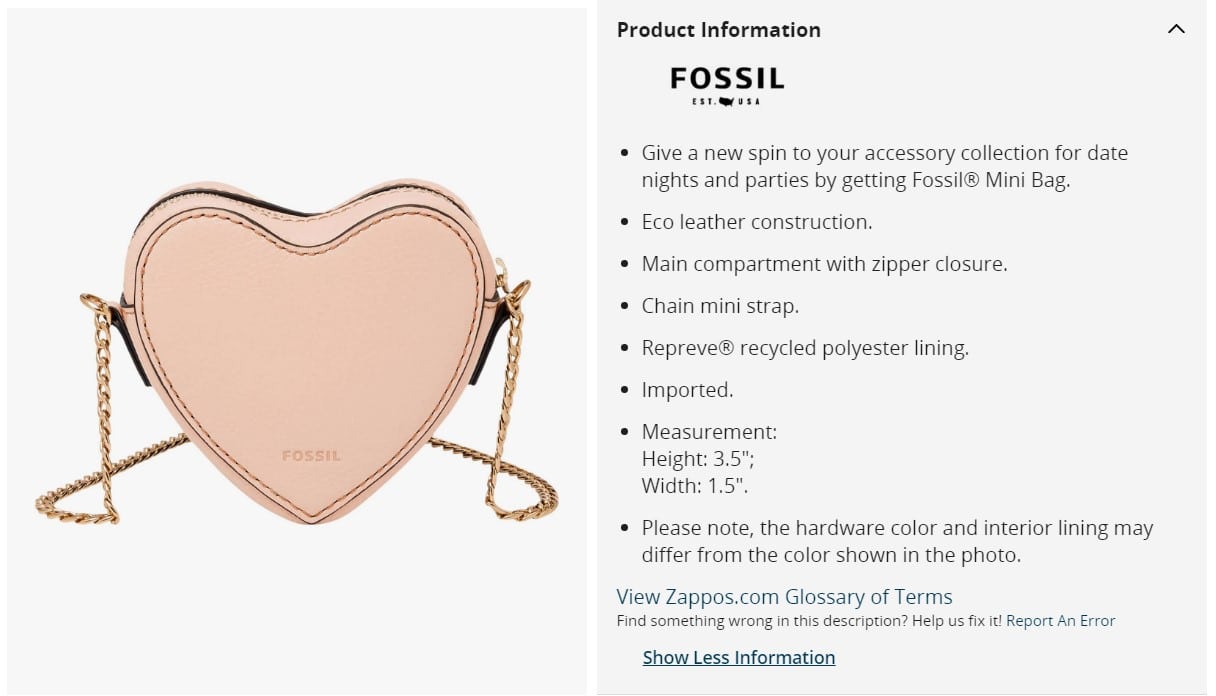


Tell a Story


People are instantly hooked by a story. It spikes their imagination and emotions. It also has a strong influence on their decision-making process.
Stories help your audience lower rational barriers against persuasion techniques and let people forget they are being sold to. Instead, they focus on experiencing the product and what it would be like to use it.
According to researchers in Spain, stories can put your whole brain to work. They proved that stories are powerful ways to plant ideas, thoughts and emotions into the listeners’ brains.



The scientists found that when you tell a story to someone, his brain is activated in the same areas as yours. This means that he’s basically experiencing the same response as you are.
Here are some great ways to use stories in your product descriptions:
- Tell stories of past customers using your product
- Tell stories of your imaginary buyer persona using the product
- Tell stories of how your readers would use your products
A great example of a product description that tells a story is Jaisalmer Dress at J. Peterman’s store.

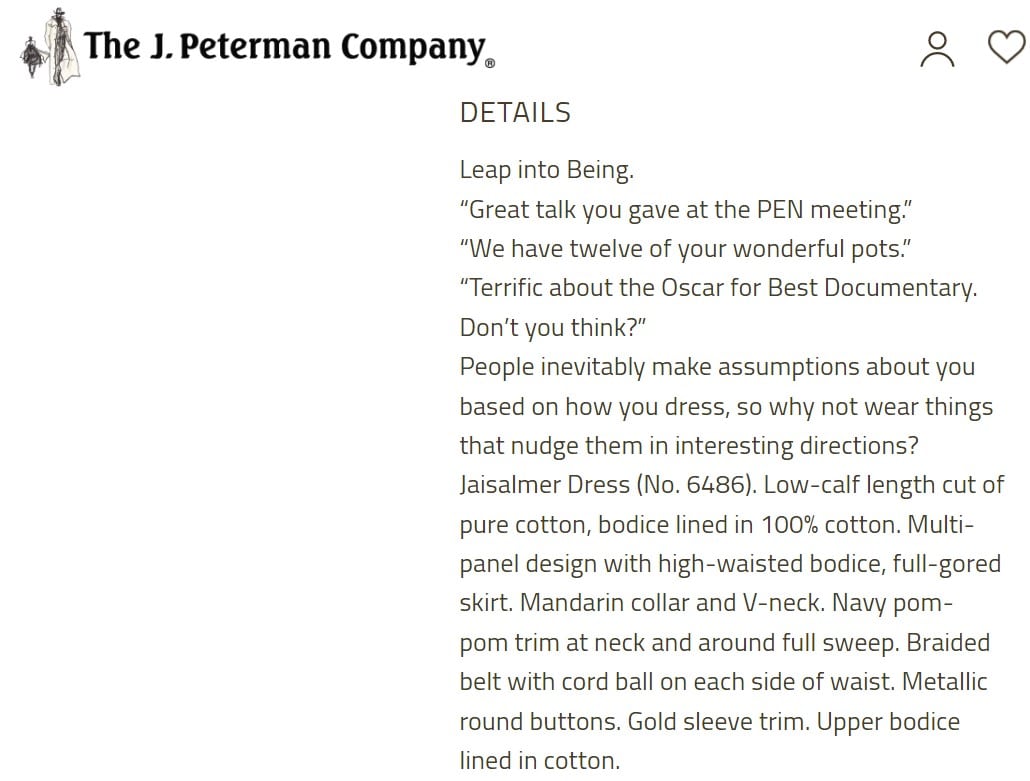


The description let the reader (a woman) imagine herself already wearing the dress and going out on a date with a man.
Use power words


Some words are just more powerful than others. In fact, there are some that are at least 100 times more effective and will sell many more products if you use them in your product descriptions.
These are words like “Free,” “You,” “New” or “Guaranteed.” Each of these words connects on a deep emotional level with your target customers. It also helps to increase the perceived value of your products.



A great example here is “Free shipping” and “Free return shipping.” The customer knows logically that the shipping is not really free and that it’s covered in the price of the product, but on an emotional level he feels like he’s getting some additional value to the product.
Use social proof


People tend to trust and be more likely to buy products that others have tried before and that turned out well for them. Nobody wants to be the first moron to buy something, especially online, and later on be disappointed for one reason or another.
In his book “Influence: The Psychology of Persuasion,” Robert B. Cialdini, Ph.D. thinks of social proof as a shortcut to influencing others. According to him, before people make a decision they look to others as a guide.
Cialdini wrote, “One means I use to determine what is correct is to find out what other people think is correct… I view a behavior as more correct in a given situation to the degree that I see others performing it.”
A recent study conducted by Sharethis and Paley Center for Media revealed that social proof, such as social sharing and online reviews of products or a brand as a whole, gives reassurance to purchasers about buying a product or service.
It was also shown that positive recommendations allowed companies to charge higher prices.
This is where social proof helps – by having testimonials from past clients you can show that others trusted you before and it paid off. They are happy with their purchase, and they even spent the time to explain why.


Including logos of the media and pictures of your clients adds additional credibility to your business.
Format it effectively – make it scannable and readable
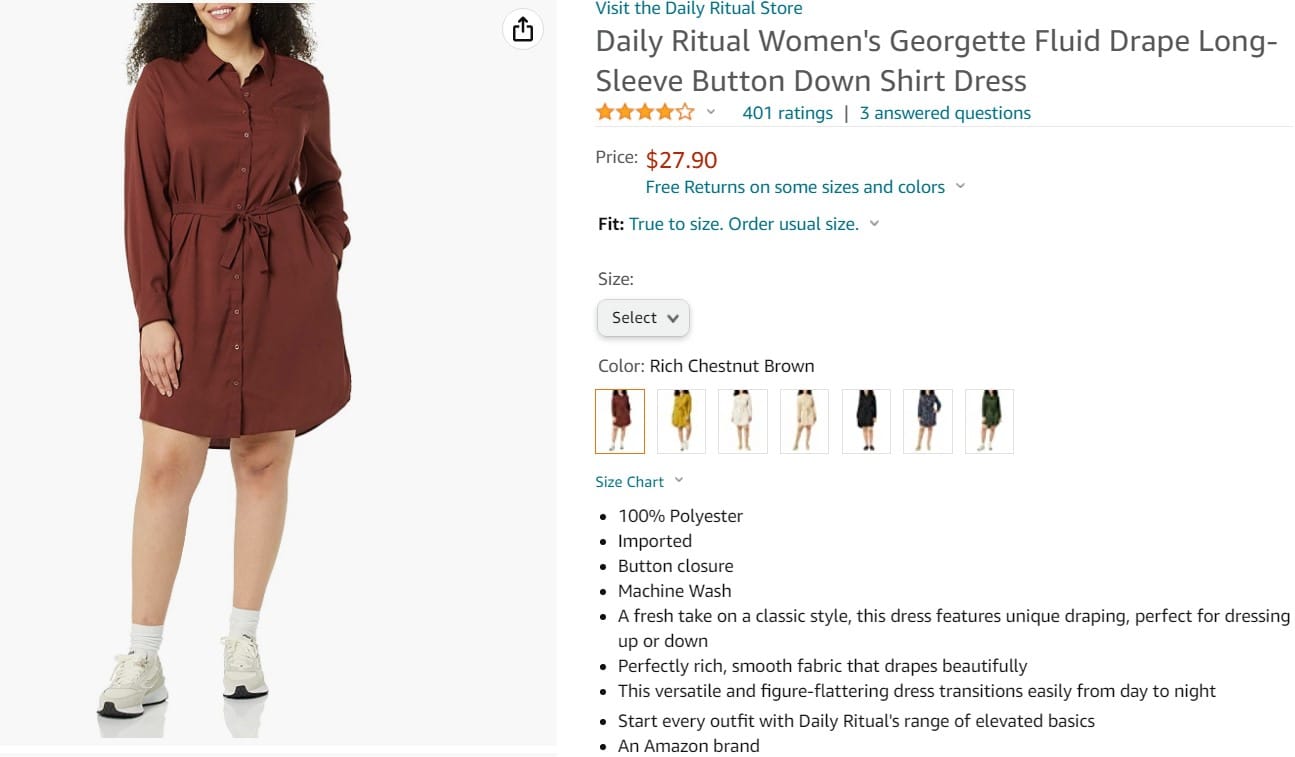


People don’t read on the web, they scan and skim. That’s why it’s extremely important to structure your description in a way that makes it easily absorbed by your audience.
To do this is not so hard. Just be sure to:
- Use subheadings within the description
- Use 2-3 sentences per paragraph
- Use numbering or bullet points
- Include plenty of white space
- Use bigger bold fronts for subheads and smaller, regular fonts for paragraph text
- Break your longer sentences into shorter ones
- Edit and remove what you don’t need
Innocent drinks are spot on in their product descriptions format:
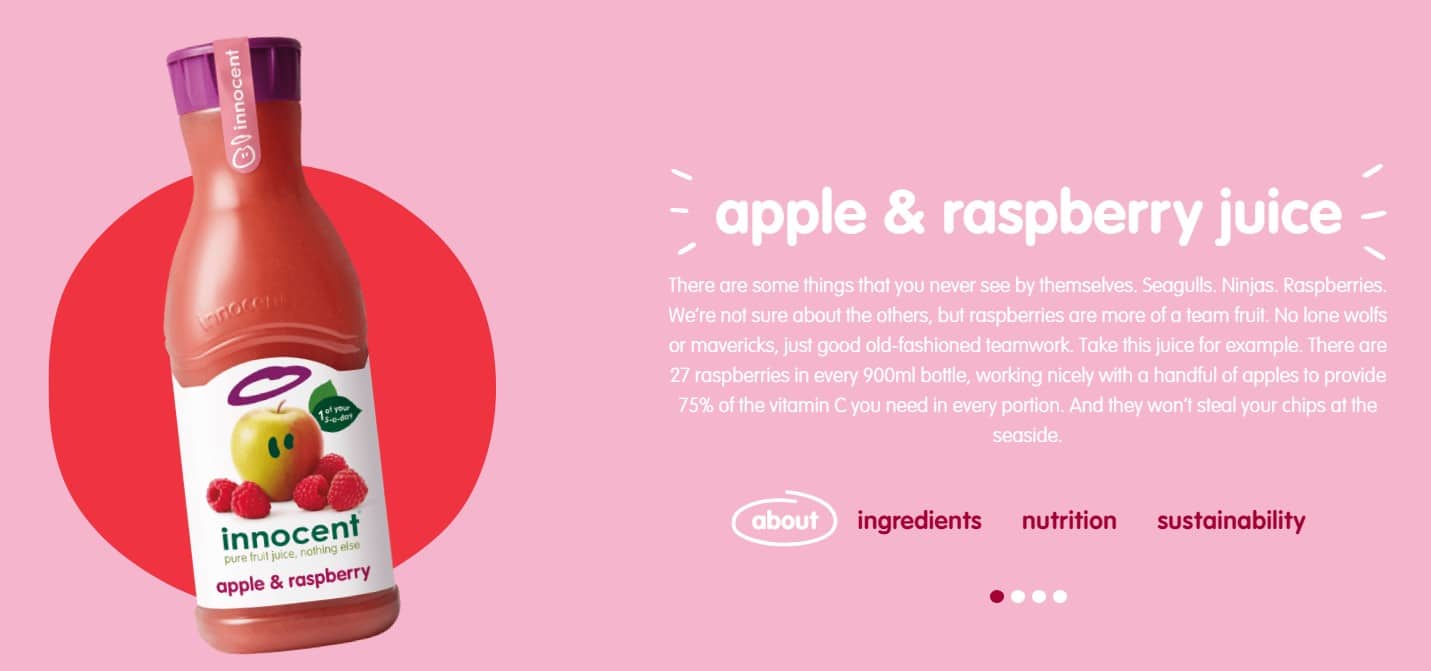


They are easy to read with important information, options, and lots of white space.
Use active voice, avoid passive


Using passive voice is one of the biggest mistakes you can make when writing your product description copy. Despite not being technically correct, passive voice sounds pretentious and convoluted. On the other hand, active voice in copywriting sounds direct, concise and authoritative.
In general, active voice is subconsciously associated with action, and it’s more likely to force your customer to take one. It’s straightforward and easier to understand.
There is no need to make things more complicated than they are, so always use active voice when possible.
Read other great product descriptions


The only way to become good at writing copy is to read lots of good copy. This is also true for your product descriptions.
This will give you an idea of what is out there, what approaches others are using, length of copy, what kind of words they use, etc.
Reading also inspires and fills up your creativity. It helps stimulate the right side of your brain and as a result, you naturally produce better copy.
To inspire yourself check out product descriptions of companies like Patagonia, Groupon, ModCloth, Filson, L.L.Bean, etc.
Also research your competitors and check if they are doing a good job with their product descriptions. If they are, use that as inspiration. Don’t just copy them. Be original, be better.
Final thoughts…
Writing good product descriptions that help you increase your conversion rates and sales might take you some time. But it’s worth it.
To do it you need to really understand your target customers and what their main motives are for buying your products. Then when you’re writing your copy, you should focus on the benefits and the experience.
Avoid using clichés and jargons. Instead, focus on power words and stories to make a better connection with your audience.
So what’s your approach to writing product descriptions for your ecommerce store? Let me know in the comments below.
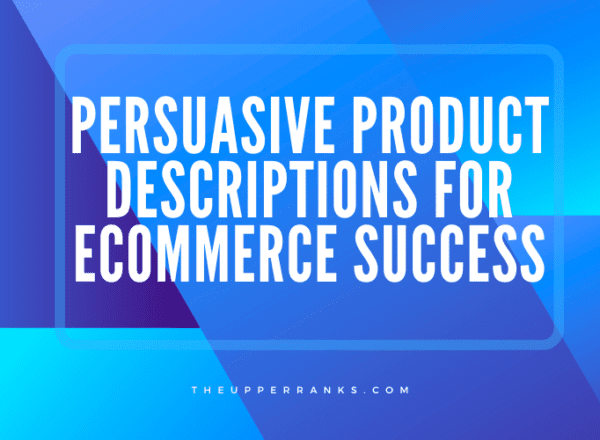
Comments